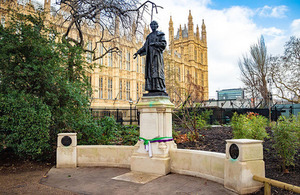Pankhurst statue given Grade II* listing to mark centenary of votes for women
The statue of suffragette Emmeline Pankhurst in Victoria Tower Gardens will be upgraded to Grade II*

- Announcement marks the end of the centenary of female emancipation
A statue of Emmeline Pankhurst that overlooks Parliament has been upgraded to Grade II* today to commemorate the centenary of women’s suffrage in the UK and the election of the first female MP.
The additional protections reflect the statute’s architectural and historical significance and the roles that Pankhurst and her daughter Christabel played in campaigning for votes for women through the Women’s Social and Politics Union (WSPU).
The Representation of the People Act in 1918 gave women aged 30 and over the age of 30 the right to vote. The following year, 1919, Lady Astor became the first woman to take a seat in Parliament.
It comes after proposed plans to relocate the statue were withdrawn earlier this year. Pankhurst is one of a small number of women whose statues have been given this status and she now joins the likes of Queen Victoria, Lady Godiva and the Virgin Mary, all of whom have Grade II* listed statues.
Heritage Minister, Michael Ellis said:
Emmeline Pankhurst was a pioneer of her time and was instrumental in securing votes for women. It is a fitting tribute that at the end of this centenary year we recognise the important role she played in securing the equality we rightly enjoy today.
Deborah Mays, Head of Listing Advice at Historic England, said:
The statue is a tribute to Emmeline and Christabel Pankhurst who were instrumental in bringing about women’s suffrage in Britain. It is a finely crafted memorial in a significant location which bears witness to the struggle and success of the movement Pankhurst led. It is fitting to give it a higher grade listing at the end of this centenary year.
Born in Manchester in 1858, Pankhurst founded the Women’s Franchise League in 1889 which fought to allow married women to vote in local elections before going on to found the more militant WSPU in 1903. It was this organisation that gained notoriety and its members were the first to be termed Suffragettes.
Along with many other Suffragettes, Pankhurst was arrested multiple times and also engaged in hunger strikes. The Suffragettes period of militancy stopped after the outbreak of the First World War in 1914 when Pankhurst turned her energies to the war effort in the hope it would benefit the Suffragette cause.
The statue was unveiled by the then Prime Minister Stanley Baldwin on 30 March 1930. In 1956 it was moved to its current position and expanded to commemorate Christabel Pankhurst, Emmeline’s daughter and active Suffragette, and members of the Women’s Social and Political Union in 1959. In 1970 the statue was granted a Grade II listed status.